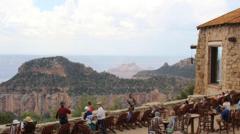The Grand Canyon Lodge, a cherished landmark located at the North Rim, has been sadly destroyed by a wildfire that intensified rapidly due to changing weather conditions. The fire, known as the Dragon Bravo Fire, engulfed the lodge that once offered stunning aerial vistas and was a vital accommodation for visitors. Davy Crockett, the vice-president of the Grand Canyon Historical Society, watched as smoke turned into flames, unable to sleep as he worried about the historic building.
On Sunday, park officials confirmed what many had feared: the devastation of the lodge, a site often described as a "balm for the weary soul" by visitors. The lodge, which stood at an elevation of 8,000 feet (2,438m), has attracted tourists from around the globe, many of whom have taken to social media to lament its destruction. "It broke my heart," Mr. Crockett said, expressing the collective grief felt by the community.
In addition to the lodge, many of the nearby cabins were also lost in the fire, which has already scorched over 5,000 acres of land. Local tour guide Karne Snickers, who has spent 24 years leading expeditions in the North Rim, emphasized the deep emotional connection many have to the lodge's breathtaking views and peaceful ambiance. "It's very spiritual there,” she noted, reflecting on the sense of loss that the community feels.
The wildfire initially began from a lightning strike on July 4 but quickly escalated beyond containment due to strong winds. Firefighters attempted to protect the lodge but were ultimately forced to evacuate when a nearby water treatment plant caught fire, releasing toxic gases. Among the casualties were ancient trees, some over 400 years old, which were lost to the flames. "Much of the beauty is gone,” lamented Mr. Crockett, who believes it could take decades for the area to recover.
The Grand Canyon Lodge, originally designed by architect Gilbert Stanley Underwood, faced a similar fate years ago, when the original structure was lost to a fire in 1932. Overcoming multiple obstacles, including a severe snowstorm during the Great Depression, the lodge was rebuilt and reopened in 1938, becoming a lasting symbol of resilience and cherished experience.
As discussions about the future of the lodge swirl, the community holds onto hope for its reconstruction. "We have to rebuild this place," Ms. Snickers expressed, emphasizing the lodge's significant place in history and the hearts of those who have visited it. The National Park Service has yet to release plans regarding the lodge's future, but many are determined to see this beloved landmark brought back to life.
On Sunday, park officials confirmed what many had feared: the devastation of the lodge, a site often described as a "balm for the weary soul" by visitors. The lodge, which stood at an elevation of 8,000 feet (2,438m), has attracted tourists from around the globe, many of whom have taken to social media to lament its destruction. "It broke my heart," Mr. Crockett said, expressing the collective grief felt by the community.
In addition to the lodge, many of the nearby cabins were also lost in the fire, which has already scorched over 5,000 acres of land. Local tour guide Karne Snickers, who has spent 24 years leading expeditions in the North Rim, emphasized the deep emotional connection many have to the lodge's breathtaking views and peaceful ambiance. "It's very spiritual there,” she noted, reflecting on the sense of loss that the community feels.
The wildfire initially began from a lightning strike on July 4 but quickly escalated beyond containment due to strong winds. Firefighters attempted to protect the lodge but were ultimately forced to evacuate when a nearby water treatment plant caught fire, releasing toxic gases. Among the casualties were ancient trees, some over 400 years old, which were lost to the flames. "Much of the beauty is gone,” lamented Mr. Crockett, who believes it could take decades for the area to recover.
The Grand Canyon Lodge, originally designed by architect Gilbert Stanley Underwood, faced a similar fate years ago, when the original structure was lost to a fire in 1932. Overcoming multiple obstacles, including a severe snowstorm during the Great Depression, the lodge was rebuilt and reopened in 1938, becoming a lasting symbol of resilience and cherished experience.
As discussions about the future of the lodge swirl, the community holds onto hope for its reconstruction. "We have to rebuild this place," Ms. Snickers expressed, emphasizing the lodge's significant place in history and the hearts of those who have visited it. The National Park Service has yet to release plans regarding the lodge's future, but many are determined to see this beloved landmark brought back to life.




















